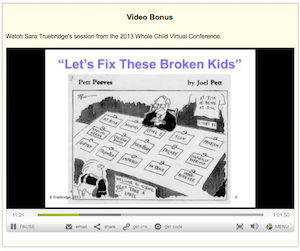Helping Kids Stick with Learning
Whether you call it grit, resilience or perseverance, it’s a behavior that will serve students well in the Common Core classroom and beyond. What may divide participants in the “gritty resolve” debate is just how educators should help students go about developing it.
This MiddleWeb Resource Roundup looks at the growth of grit awareness and at current evaluations of what is most likely to increase kids’ determination to learn the hard stuff.
21st Century Grit

Another word in play in this conversation is “rigor,” the preferred term of educator/author Barbara R. Blackburn, whose writings and presentations focus on helping students, teachers and principals develop resilience for rigorous learning. Visit Blackburn’s website for extensive free resources including such articles as The Seven Myths of Instructional Rigor. In it she defines rigor as “creating an environment in which each student is expected to learn at high levels, each student is supported so he or she can learn at high levels, and each student demonstrates learning at high levels” (Williamson and Blackburn, 2011). Blackburn contends that, based on her experience as a teacher, “any student can reach higher levels with the right support.” She includes several resources related to the Common Core.
Pushback from Educators
In 2012, the concept of “grit” gained further prominence with Paul Tough’s How Children Succeed: Grit, Curiosity and the Hidden Power of Character. At the time, veteran teacher and Education Week blogger Nancy Flanagan responded by noting that “Individual grit is a good thing. But without a compassionate society and open opportunity, it’s only half the equation.” Flanagan pointed out that grit is not a new concept in education and included several helpful links at her Teacher in a Strange Land blog.
The most vivid pushback against unbridled enthusiasm for rigor and grit that we have found comes from Furman University professor P.L. Thomas, who taught for 18 years at a Title I high school in South Carolina.
Children in poverty line up at the starting line with a bear trap on one leg; middle-class children start at the 20-, 30-, and 40-meter marks; and the affluent stand at the 70-, 80-, and 90-meter mark. And while gazing at education as a stratified sprint, ‘no excuses’ reformers shout to the children in poverty: ‘Run twice as fast! Ignore the bear trap! And if you have real grit, gnaw off your foot, and run twice as fast with one leg!’ These ‘no excuses’ advocates turn to the public and shrug, ‘There’s nothing we can do about the trap, sorry….’ In the race to the top that public education has become, affluent children starting at the 90-meter line can jog, walk, lie down, and even quit before the finish line. They have the slack necessary to fail, to quit, and to try again—the sort of slack all children deserve.”
Speaking of students generally, Grant Wiggins (Understanding by Design, 2005; Educative Assessment, 1998) writes about the difference between backbone and character in a 2012 blog post titled Why Insisting On “Grit” In Learning Is Missing The Point: Character Training:
“The essence of character is not mere backbone. As Dewey said, it is good judgment borne of having learned to really think and to be held accountable for one’s judgments by the demands of schooling…. And so, to ask kids to “persist” in the face of boring and isolating work conditions is not only somewhat hypocritical but borders on cruel. It certainly isn’t preparation for a successful life – it’s not enough to be really good at delaying gratification and trusting adults. You have to have a passion and a purpose, and typical schools often work against it.”
What’s a Teacher to Do?

In an insightful hour-long video that accompanies the article (part of the 2013 Whole Child Virtual Conference), Truebridge relates research on resilience to specific strategies teachers can implement.
In Three Pillars for Supporting Resilience, instructional coach Cheryl J. Wright provides a succinct reminder of the teacher dispositions that can help build resilience. Her ASCD Express post also outlines the elements needed to provide a nurturing classroom and student centered teaching. Another list of essentials comes from school PD director Bryan Harris (Battling Boredom, 2011) in Building Resiliency in Struggling Students: 7 Key Ideas from Research. Building on calls for less testing and more time for concern from teachers, Harris summarizes the key ideas, citing the research upon which they are based. Several themes may be familiar; others may suggest actions to take today. At the end of the post, commenter ASD-J adds two more elements to build student resilience.
Anthony Cody, a veteran educator and coach in the high-poverty Oakland CA schools, shares strategies to help students persevere, gleaned from his years as a middle school teacher, in Students Can Do Hard Things, a MiddleWeb guest article. Among them: periodic reviews of portfolios, fewer letter grades and more suggestions, evaluation of effective projects before launching into new ones, and more. He concludes: “Our students can do hard things, but they do not always know that. High self-regard is important for all the kids we teach, but it is not built through empty praise. It grows as the student actually succeeds in creating quality work.”

In her MiddleWeb guest article The Power of Teachers’ Words Debbie Silver (Fall Down Seven Times, Get Up Eight: Teaching Kids to Succeed, 2012) writes: “Effective feedback starts with carefully selecting words that are honest, specific, nonjudgmental, and specifically chosen to help the student figure out how to get better. It should inform them about their progress. It should not judge, label, accuse, excuse, or even praise. It provides instructive knowledge that will enhance the student’s performance.” Silver provides the theory behind effective feedback and offers examples of the good and the bad.
Building Teacher Grit
After briefly noting the realities of high-needs public schools that often stress educators, Education Week blogger and transformational leadership coach Elena Aguilar outlines How Teachers Can Build Emotional Resilience. A key element in her discussion is the part principals can play in providing opportunities for teachers to shore up their emotional resilience.

Both students and teachers can benefit from understanding ‘growth mindset,” the research-supported idea that when we see ourselves (and our students) as individuals with minds that are always capable of growing, new learning abounds. Watch for a MiddleWeb Resource Roundup focusing on fixed vs. growth mindset soon. In the meantime visit Carol Dweck’s “Even Geniuses Have to Work Hard.”
More Good Stuff
For up-to-the-minute posts as well as resources reaching back to 2011 on grit and resilience, visit Larry Ferlazzo’s The Best Resources For Learning About The Importance Of “Grit.”
The September 2013 issue of ASCD’s Educational Leadership is devoted to the theme “Resilience and Learning.” Many of the articles are locked (members only). There are also some really good public articles, some of which are included above. Find more at the September 12, 2013 issue of ASCD Express.
Resource Updates:
January 2014 – Build perseverance into classroom experience with ideas from Andrew Miller’s ‘5 Steps to Foster Grit’ at Edutopia.
March 2014 – MindShift’s Can Focus On ‘Grit’ Work In School Cultures That Reward Grades? gives background and pushback to the current surge in gritty classrooms. Lots more resources provided by commenters.
April 2014 – Ten concerns about the ‘let’s teach them grit’ fad by Alfie Kohn, adapted from his book, The Myth of the Spoiled Child: Challenging the Conventional Wisdom about Children and Parenting, appeared in the Washington Post’s Answer Sheet.
April 2014 – Heather Wolpert-Gawron asks Do You Remember the Moment When You First Learned “Grit?” in her TweenTeacher blog post. She suggests grit can be learned but not taught and offers ways schools can help students develop grit.
July 2014 – What do the best teachers do to make their classrooms both challenging and supportive? Teaching experts Annette Breaux & Todd Whitaker contrast the typical characteristics of effective and ineffective classrooms using two simple but compelling bullet lists.
October 2014 – When we ask students to accept challenges and work harder, we want to be sure we know what they need to work on and where they need our support. Better classroom assessment is critical, says ‘Smarter Grading’ author Myron Dueck, who tells how he changed the way he tests and assesses students and manages project learning.
December 2014 – Resilience goes hand in hand with engagement, and student disengagement is a major challenge for middle school teachers, says NSF-funded researcher Jennifer A. Fredricks. In Teachers Really Can Engage All Our Students, the teacher educator offers strategies to build community and craft learning opportunities that encourage students to actively participate and succeed.
Susan B. Curtis is the co-editor of MiddleWeb



































Thank you so much, Susan, for highlighting our article and for all the work you do with resilience! I also invite you to check out–and pass on to others–my new website and my new book, Resilience Begins With Beliefs: Building on Student Strengths for Success in School.
Thanks again! We are all in this together!!! ~Sara
P.S Please take the poll on my site and I encourage you, and others, to comment on my blog.